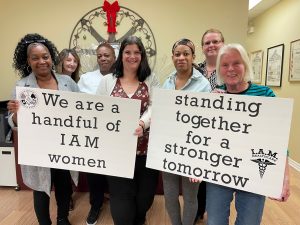International Women’s Day

International Women’s Day
A day celebrated around the world; to recognize the achievements of women without divisions; cultural, economic, or political.
The growing movement that is International Women’s Day has been strengthened by four of the Global United Nations Women’s Conferences and has helped build support for women’s rights and participation in political and economic levels globally.
Officially Recognized by the UN in 1977, International Women’s Day started with the labour Movements in the early 1900s in North America and in Europe.
In 1908, the Socialist Party of American designated February 28 as a day of honour for the garment workers’ strike in New York, women took a stand and protested their poor working conditions.
But the first milestone for Women’s rights was actually, much earlier in history- 1848- two Americans Elizabeth Cady Stranton and Lucretia Mott brought a few hundred People together at the first “Women’s rights conventions” in New York. Together they fought for civil, social, political, and religious rights of women.
In 1910 the Socialist International established a Women’s Day to honour the movement of women’s rights to build support in achieving universal suffrage for women.
In 1911 several European countries along with the United States celebrated Women’s Day on the 19th of March, in commemorations of the revolution in 1948.
International Women’s Day because a way to protest World War 1 in 1913 Russia, where they recognized the movement on the last Sunday of February. Around Europe the following year women held rallies at the beginning of March to protest the way.
Why March 8?
While Women’s Day had many recognized dates around the world, March 8 came from Julius Cesar and Gregory XIII. Before the revolution, Russia had not adopted the Gregorian calendar, introduced by Pope Gregory in 1582, to mitigate errors found on the Julian Calendar, because of these errors in the calendars, February 23rd in Russia corresponded to March 8th for the rest of the world.
From the Early Trailblazers to today’s leaders for change, the long journey of Women’s suffrage toward equal rights, opportunities and freedom for all, women continue to fight to create a better and more equal and safer world for all. The fight is not over and politically many are trying to take steps backward in time reducing the rights women had fought for and won.
Canadian Women’s History timeline has some extremely powerful women who created change-
1645: Jeanne Mance, founder of Canada’s first hospital
1813: Laura Secord, Canadian heroine of the War of 1812
1853: Mary Ann Shadd Cary, first Black newspaperwoman in North America
1867: Dr. Emily Stowe, first Canadian woman physician to practice in Canada
1875: Grace Annie Lockhart, pioneer of women’s university education
1897: Clara Brett Martin, Canada’s first woman lawyer
1903: Emma Baker, first woman to receive a Ph.D. from a Canadian university
1914-1918: First female officers served with the Canadian Army Medical Corps
1916: Women in Manitoba became the first in Canada to win the right to vote
1917: Louise McKinney and Roberta MacAdams Price, first women elected to a legislature in the British Empire
1918: Some women were granted the right to vote in federal elections
1921: Agnes Macphail, first woman elected to the House of Commons
1924: Cecile Eustace Smith, first Canadian woman to represent Canada in an Olympic Games
1927: The Famous Five, petitioners in the groundbreaking Persons Case
1929: Women were declared as “persons.”
1941: Women’s Divisions are established in the Army Corps and the Royal Canadian Navy
1954: Elsie Knott, first woman elected chief of a First Nation community
1960: All Canadian women were given the right to vote
1967: The Royal Commission on the Status of Women was established
1969: Réjane Laberge-Colas, first woman appointed as a judge to a superior court
1970: Report of the Royal Commission on the Status of Women was tabled in Parliament
1971: The Canadian Labour Code was amended
1977: The Canadian Human Rights Act was created
1979: Nellie J. Cournoyea, first woman to serve as premier of a territory
1981: Women’s rights were enshrined in the Charter of Rights and Freedoms
1983: Jeanne Sauvé, first woman to serve as Governor General of Canada
1987: Combat roles in the Royal Canadian Air Force are opened to women
1992: Dr. Roberta Bondar, first Canadian woman astronaut sent into space
1993: Jean Augustine, first Black Canadian woman elected to the House of Commons
1993: Kim Campbell, first woman Prime Minister of Canada
1995: Beijing Declaration and the Platform for Action was adopted
1996: Sexual orientation was added to the Canadian Charter of Rights and Freedoms
2001: Canadian Human Rights Commission recommends a pay equity system
2001: A task force to address pay equity was appointed
2004: The Standing Committee on the Status of Women was established
2005: Same-sex marriage became legal nationwide
2009: Josée Kurtz, first woman to command a major Canadian warship
2012: Canada leads a successful international campaign at the United Nations to establish the International Day of the Girl
2015: First gender-balanced Cabinet in Canadian history was announced
2015: National Inquiry into Missing and Murdered Indigenous Women and Girls was launched
2017: Gender expression and gender identity were added to the Canadian Human Rights Act
2017: Canada took action against gender-based violence
2019: Karen Jensen, first-ever Canada’s Pay Equity Commissioner
2019: Final Report of the National Inquiry into Missing and Murdered Indigenous Women and Girls was released
2022: The endorsement of the National Action Plan to End Gender-Based Violence – a significant step towards gender equality
Sources
Background | International Women’s Day | United Nations
Women in Canadian History: A Timeline – Women and Gender Equality Canada
